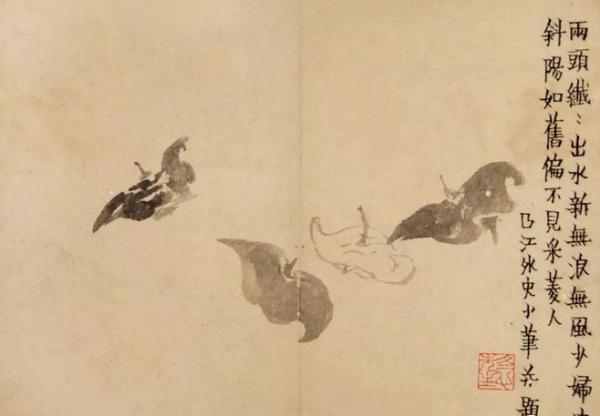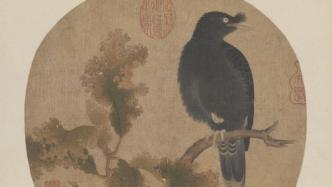
On September 28 of the lunar calendar, frost falls.
During the frost season, the grass and trees begin to turn yellow, entering the late autumn of "thousands of trees sweeping into yellow". Tang Bai Juyi's poem said: "The frost falls in the early morning, and the breeze blows. Tang Yuanzhen has a saying that "after the frost falls for thirty days, there will be one leaf in autumn".
Among the famous works of calligraphy and painting in the past dynasties, Song people observed the descriptions of small scenes in late autumn with particular attention to detail. It is called the ultimate; on the page of "Birds of Frost Tallow Mountain", the leaves are sparse, and the tips of the leaves are slightly reddish after frost, and the colors are bright and uncommon; on the page of "Shuang Xiaohan Chicks", the bamboo branches under the withered thorns are yellow and the leaves are sparse, Pointed out Sesser Qiuyi.
Since the Song Dynasty, the fan page of Shen and Zhou's "Autumn Forest" in the Ming Dynasty is self-titled "The autumn wind will leave the leaves, so it blows on the temples"; Qinghuayan's "Autumn Trees and Birds" axis depicts the yellow leaves falling, a scene of late autumn; modern Fu Baoshi The axis of "Autumn Wind and Red Rain" is written in Shi Tao's poetry. A gust of autumn wind hits, and the leaves are colorful, as if the red rain is falling, and the artistic conception is sparse.
On the occasion of this late autumn festival, "The Paper: Ancient Art" specially combs the plants and trees in the paintings collected by the Palace Museum and the Taipei Palace Museum for readers.
Song Autumn Tree Kingfisher Figure Page
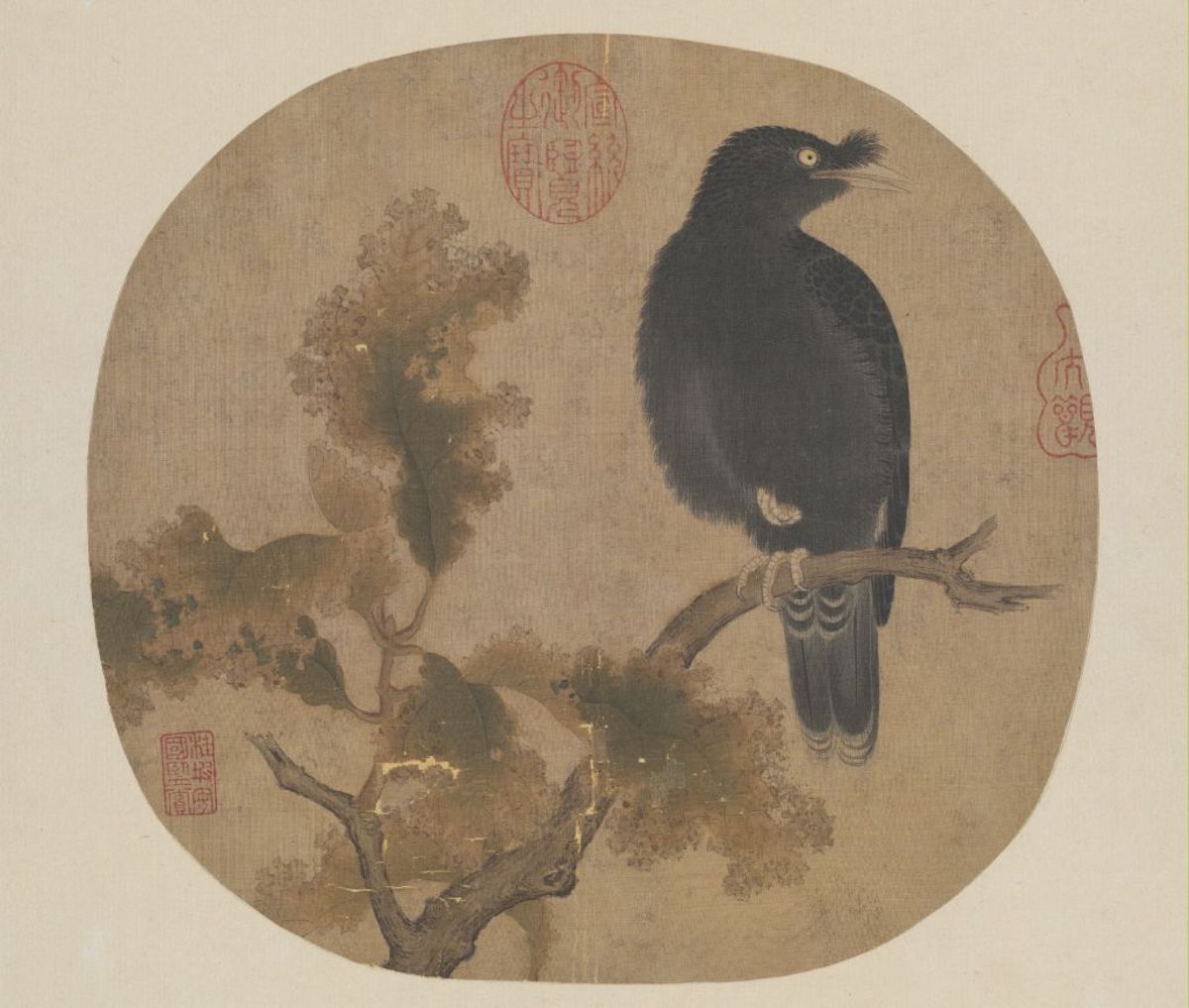
Song Autumn Tree Golden Goblin Picture Page Collection of the Palace Museum
The picture shows a golden owl perched on a tung tree in autumn, with its sharp claws gripping the branches, twisting its neck and looking sideways as if listening intently. The golden eagle has sharp eyes, plump body, neat tail, black and bright feathers, and leaves are covered with insects, curled up, and withered in color. The composition is strange and abrupt, and it is very unusual. The bird is pure black, so the whole body is dyed with ink, but the texture and level of the feathers of different parts are fully expressed, and it is more than "ink divided into five colors"! This is the magic of ancient Chinese ink painting. Under the painter's superb technique, the decayed leaves "turn decay into magic", outline and smudge, with rich layers. This is the reason why Chinese meticulous painting often depicts diseased leaves. And the leaves of this picture are the ultimate.
Songshuang Tallow Mountain Bird Map Page
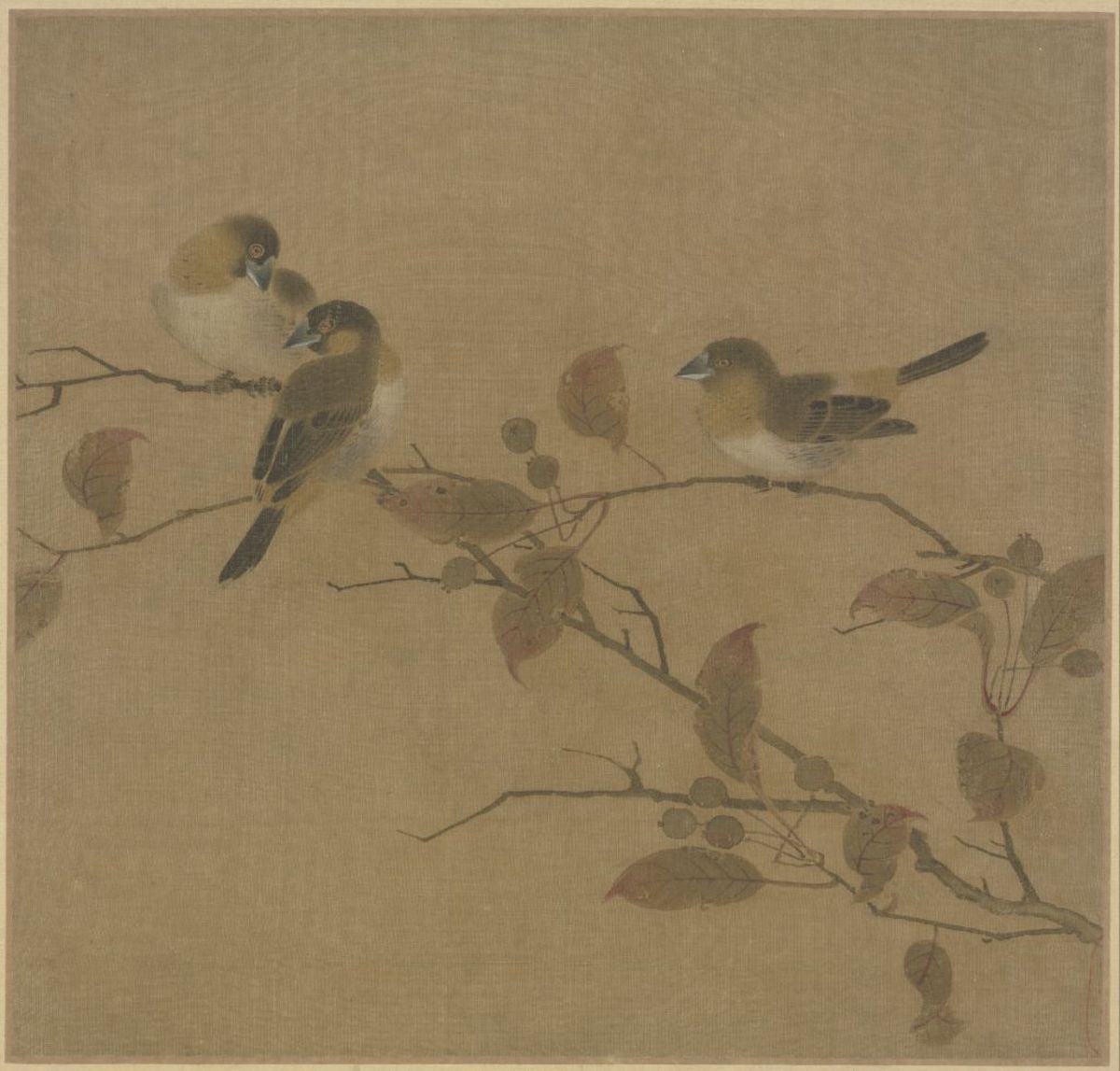
Song Shuang's Aerial Map of Tallow Mountain in the Palace Museum Collection
There is no item on this page. Half-print is indistinguishable.
The picture shows a branch of black tallow, the leaves are sparse, and the tips of the leaves are slightly reddish after frost. The fruit is full of branches, indicating that it is late autumn. The three literati in different postures perched on the branches. The branches are drawn with a thick ink stroke, and the veins and twigs are outlined in ochre. Leaves and small fruits are painted without bone. The turning of the leaves and the twists and turns of the branches are all detailed.

Songshuang Tallow Mountain Aerial Page (Part) Collection of the Palace Museum
The feathers of the wenniao are drawn from the center-point fine brush, and the different parts of its body are lightly dyed with white powder, ochre, and light and dark ink, which is delicate and realistic. The composition is sparse and clear, the combination of movement and stillness, and the colors are bright and not vulgar. This is a meticulous work in the Southern Song Dynasty sketches.
Song Shuang and Xiao Han
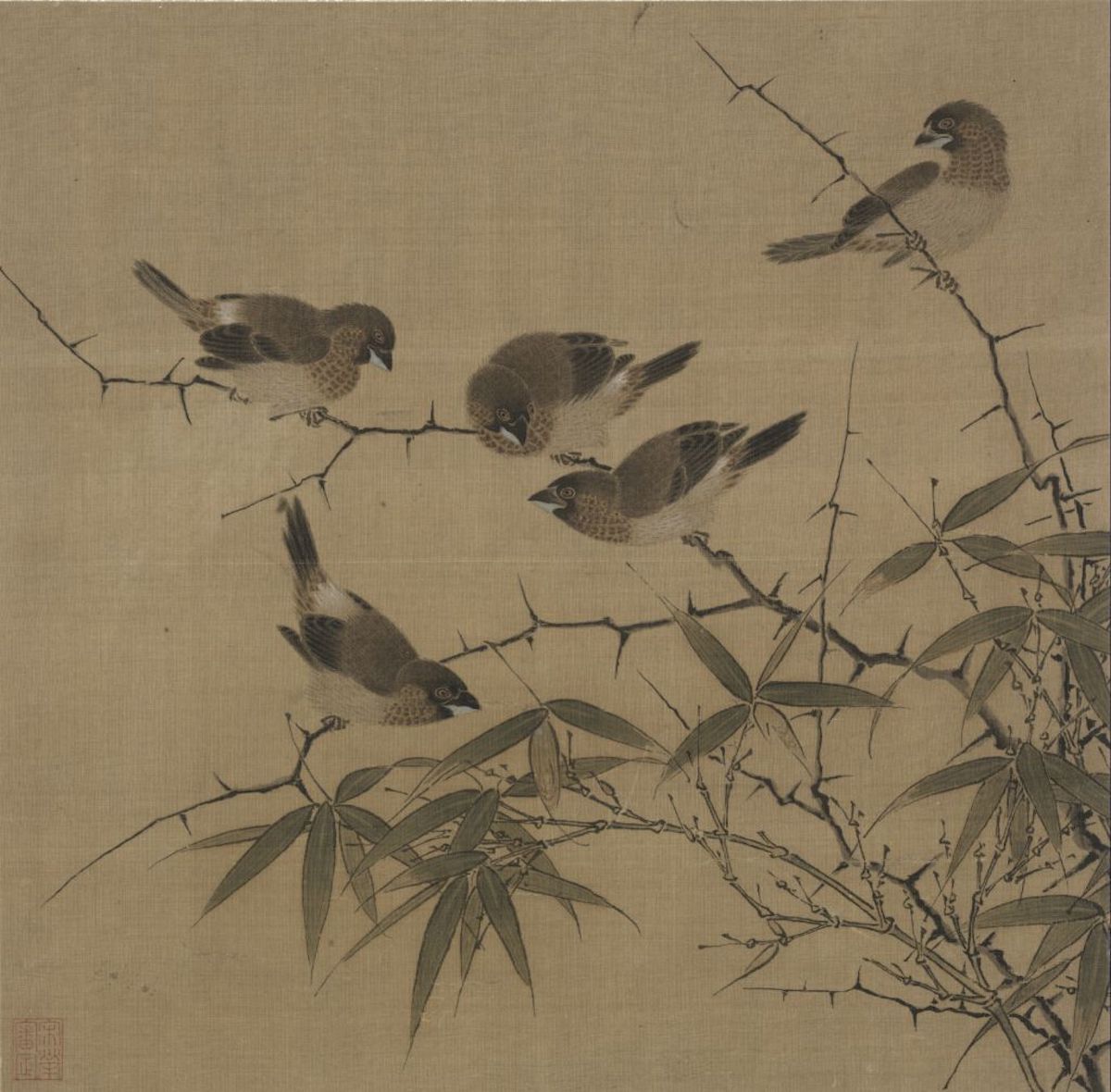
Song Shuang and Xiaohan's Young Children in the Collection of the Palace Museum
There is no item on this page. Collection of seals "Song Luan Approval". Inscribed on the side of the frame: "Song people painted frost Xiaohan young".
Five literati birds are assembled on dry thorns, with different postures and lifelike expressions. The bamboo branches under the dead thorns are yellow and sparse, which points out the serenity of autumn. The painter placed the center of gravity of the four literati birds on the left of the center of the picture, and painted another literati bird on the high thorn branch on the right to disperse the center of gravity, but its downward gaze echoes the other 4 birds. , such a layout makes the picture both well-proportioned and focused. In the depiction of the bird, the outline is drawn first, and then the feathers are drawn with a thin stroke, and light ink, ochre and other colors are applied to render the plush texture; the bamboo leaves use the double hook method, and then render; the bamboo poles use the line drawing method; The thorns are drawn in one stroke, appearing vigorous and old.
"Shiqu Baoji" description.
Yuan Ni Zan ancient wood, bamboo and stone axis
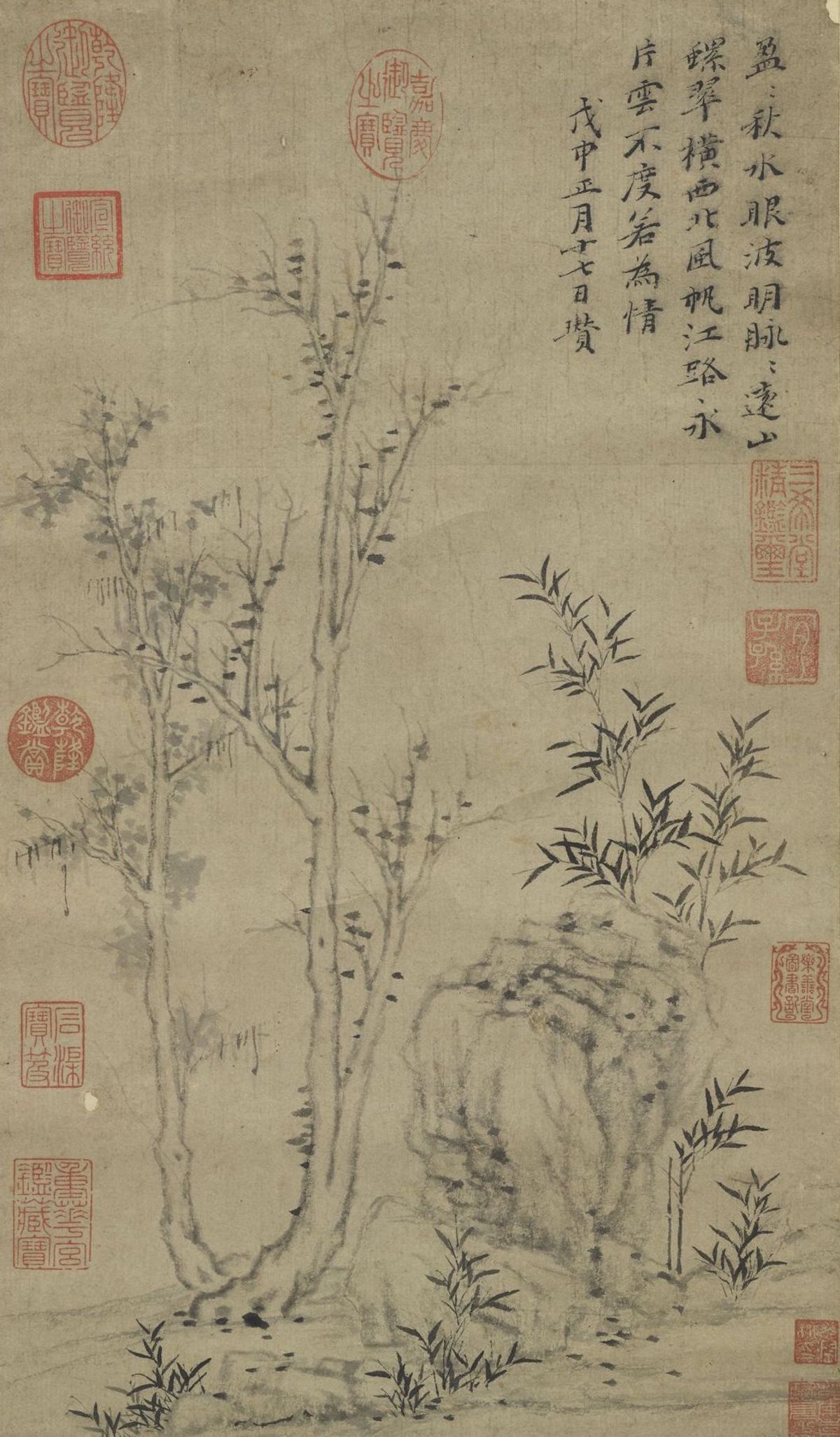
Yuan Ni Zan Ancient Wood, Bamboo and Stone Scroll Collection of the Palace Museum, Taipei
This piece has Ni Zan's own inscription in regular script: Yingying, autumn water, bright eyes, and the veins of distant mountains and green snails. The northwest wind sails the river and the road is forever, and the clouds are not too far away. Wushen (1368) on the seventeenth day of the first month, Zan.
Ming, Shen, Zhou, Qiu Lin, Fan Page
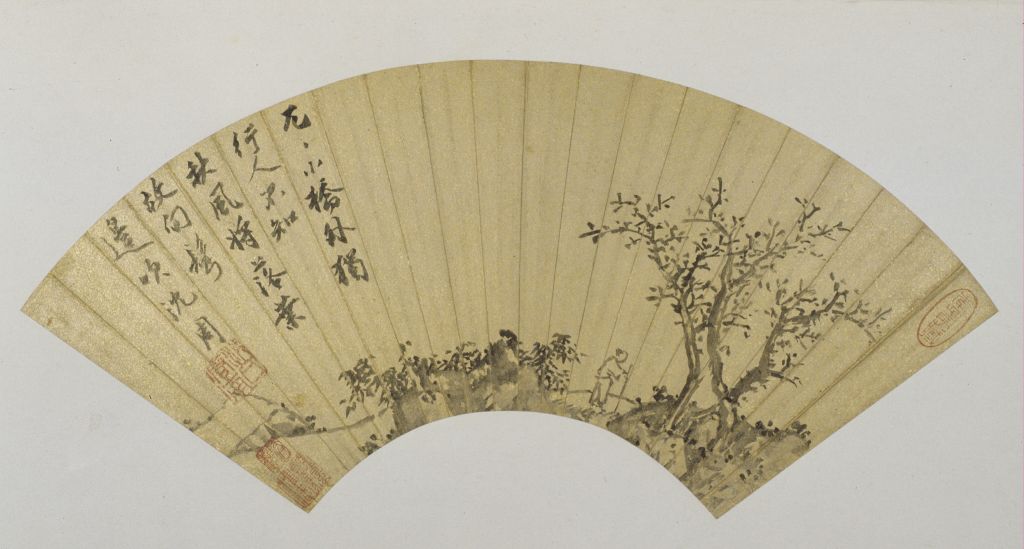
Ming Shen, Zhou Qiu Lin map fan page collection of the Palace Museum
Inscription on the fan page: "Outside the small bridge in Wuwu, people walking alone don't know. The autumn wind will blow the leaves, so it blows on the temples. Shen Zhou."
In the late autumn season when the leaves are falling, Gao Shi is walking alone with his cane. Throughout Shen Zhou's works, there are two styles of painting, thick and thin. This picture belongs to the thick brush strokes of Shen Zhou in his later years. In terms of creation, he uses his good center, moisturizing ink to dye the image, with a round, deep and strong visual effect, so that the picture does not appear thin due to the simplicity of the composition, and at the same time, through this sketch, he expresses the characteristics of the thick ink.
The plain text shows the dead wood and sparsely sparsely
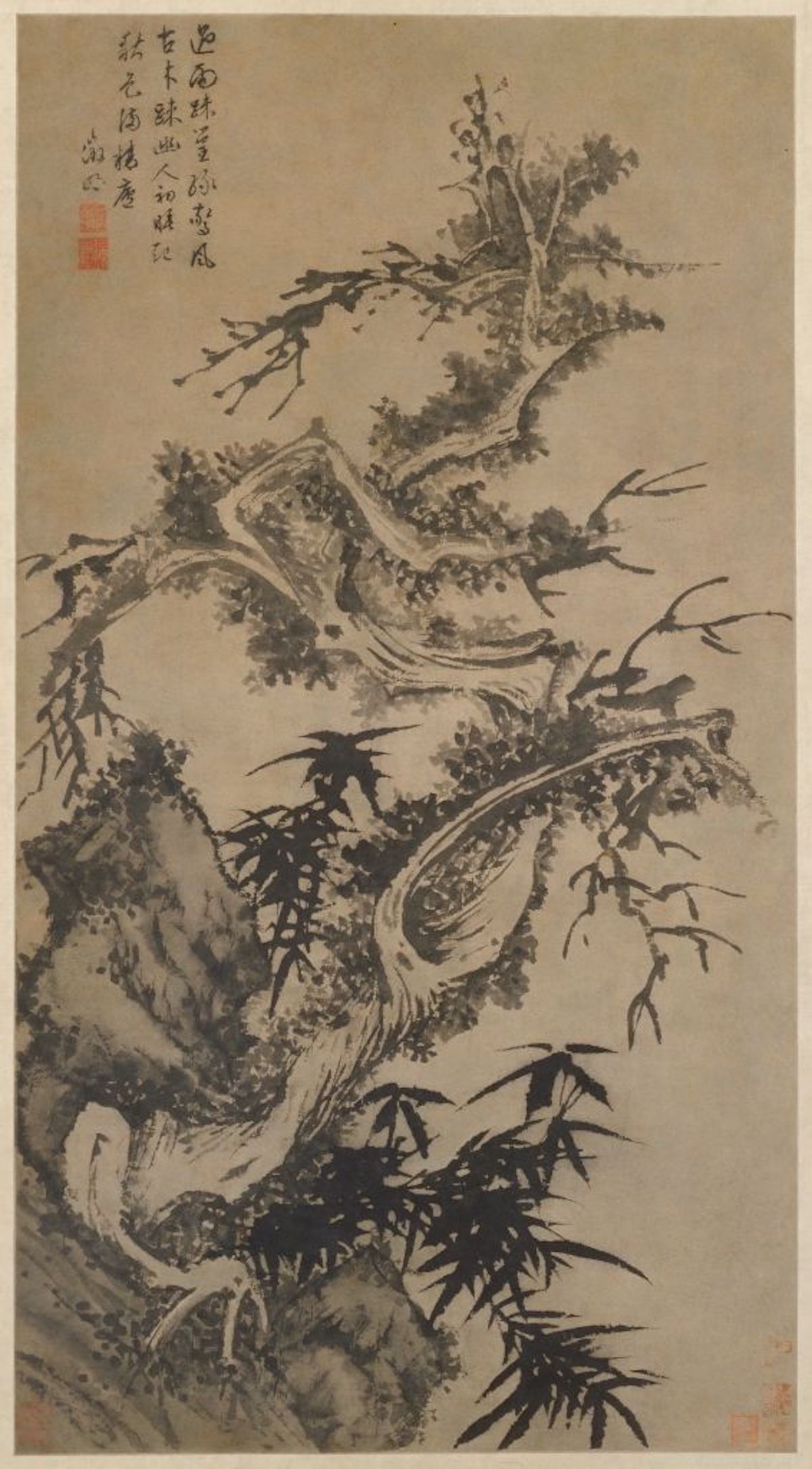
Mingwen Zhengming withered trees and sparse bamboos
The title of this painting is: "After the rain, the trees are sparsely green, and the ancient trees are sparse in the wind. The quiet man wakes up at the beginning of his sleep, and the autumn colors are full of fine houses. Zhengming."
This picture depicts ancient pines like dragons, with dry and crooked branches, old-fashioned in autumn; sparse bamboos are full of emerald green colors and covered in clusters. The artist used his profound knowledge and virtuosity in calligraphy, especially cursive script, to write freely in wet and dripping ink, which not only showed the state and beauty of the bamboo trees after the rain, and the autumn feeling was getting stronger, but also reflected the The author's relaxed and relaxed state of mind is one of the works of Wen Zhengming's thick brush painting with strong brush and ink personality and poetic artistic conception.
Ming Chen Hongshou Ancient Wooden Double Dove Chart Scroll

Ming Chen Hongshou Ancient Wooden Double Dove Scroll Collection of the National Palace Museum, Taipei
Chen Hongshou (1598-1652), courtesy name Zhanghou, and nicknamed Laolian, was born in Zhuji, Zhejiang Province, after Jiashen. The painting method is elegant, good at landscapes, especially in figures.
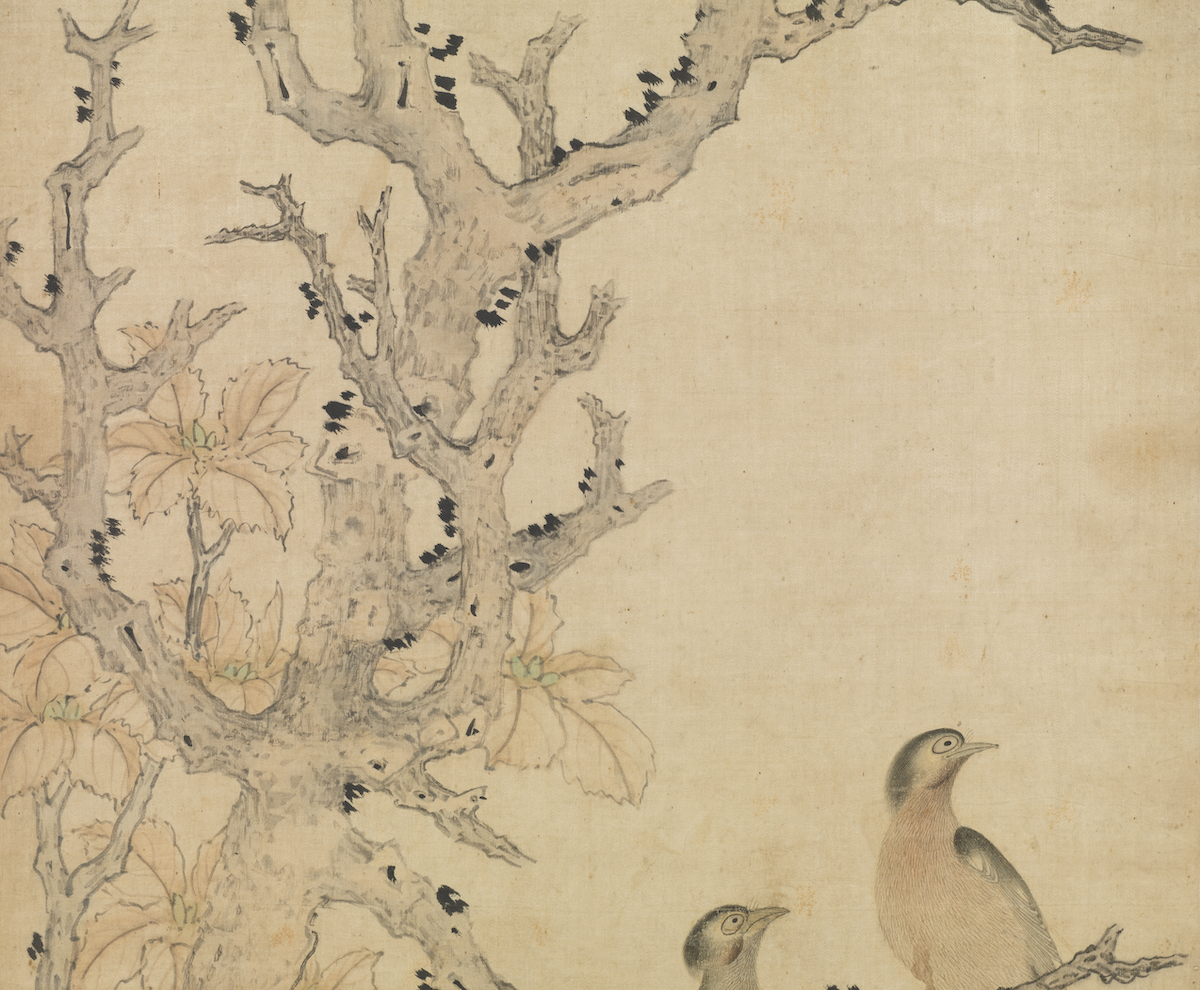
Ming Chen Hongshou Ancient Wooden Double Dove Scroll (Part) Collection of the National Palace Museum, Taipei

Ming Chen Hongshou Ancient Wooden Double Dove Scroll (Part) Collection of the National Palace Museum, Taipei
The old tree is painted with baldness, without twigs, and double doves perched on it. There is a large-leaf tree behind the tree, and the underside of the tree is lined with thorns and slope stones. The branches of the ancient wood are round and vigorous like a seal script, the thorn pen is crisp and has escapement, the slopes and stones are ups and downs, and the choke method is smooth and agile. The scorched ink and the large brush point the moss, increasing the fineness of the police. Ayamoto is bright and clean, the colors are very dull, the autumn colors are wild and cold, and it is vivid on the paper.
Ming Lanying autumn old sycamore axis

Ming Lanying autumn old sycamore axis
Lan Ying (born in 1585, still alive at the age of 80), a native of Qiantang, Zhejiang. Named Uncle Tian, numbered Diesou, also called West Lake Wai Shi, and later called Stone Tuo. Good at painting landscapes, flowers and birds. The artist took care of his intentions, and painted birds with branches, hooks and leaves, which was quite easy. When the painting goes up and down, there is a flying bird, and as soon as it stops, the branches and leaves sway slightly. Xiao Shu's layout is naturally the inscription: "Painting the old phoenix tree in autumn".
Tsinghua Rock Autumn Tree Fighting Bird Chart Axis
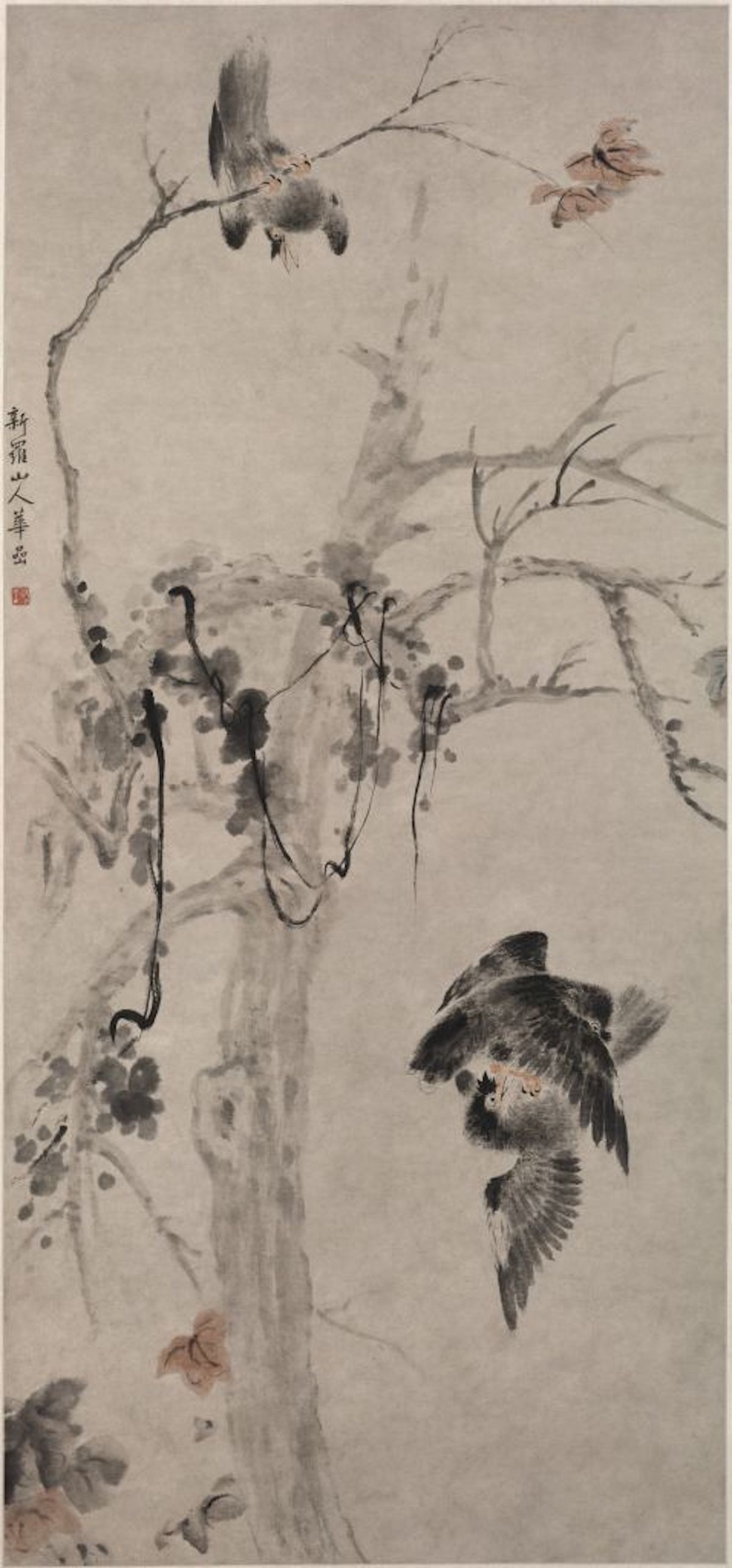
Tsinghua Rock Autumn Tree Fighting Bird Chart Scroll Collection of the Palace Museum
This picture depicts an ancient tree, with vines entwined on its branches, and yellow leaves fluttering, a scene of late autumn. A black owl (Yin Quyu, commonly known as myna) hangs upside down on a branch, watching the other two who are fighting in the air. They are fighting fiercely and the plot is quite interesting, which enhances the life and vividness of the painting.
The brush is flexible and fresh in the whole painting, the dead branches and vines are freehand brushwork, and the feathers are written with the method of concurrent work. The combination of virtual and real is a representative work of Fahrenheit freehand painting.
Modern Fu Baoshi Autumn Wind and Red Rain Chart Axis
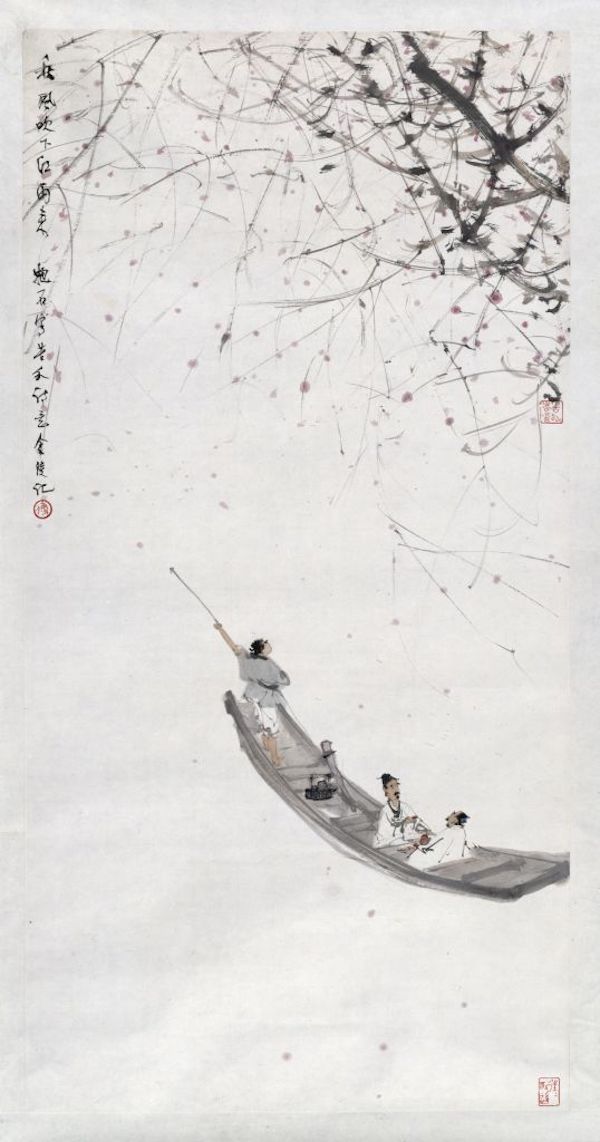
Modern Fu Baoshi Autumn Wind and Red Rain Chart Scroll Collection of the Palace Museum
The title of this picture is: "The autumn wind blows the red rain. Bouldering to write the poetry of bitter gourd, Jinling Ji."
"The autumn wind blows the red rain" was originally a poem by Shi Tao, a painter in the early Qing Dynasty. Fu Baoshi highly praised the innovative spirit of Shi Tao's painting, and then conducted in-depth research on his deeds and art, and published a number of papers one after another. It can be said that he has reached the same level of thought and spirit of Shi Tao, and has a profound and meticulous understanding of his poetry, so the intention of Shi Tao's poems fully reflects the spirit of the original text. The two scribes in the picture are sitting in a boat, communicating with each other, drinking to help talk about money, and they are very interested. A gust of autumn wind came, and the leaves were colorful, as if the red rain was falling, and the artistic conception was sparse. The branches in the upper part of the picture are uneven, and there is only one boat at the bottom, one complex and one simple, complementing each other. The composition does not seek to be dense, clean and neat, and the theme is pointed out, and the artistic effect of simplicity and comprehensiveness has been achieved.
Modern and Modern Xu Beihong's Double Magpies in Autumn

Modern and Modern Xu Beihong Double Magpies in Autumn and Yan Scroll Collection of the Palace Museum
Self-titled: "Written by Beihong in the Autumn of Thirty Years." Collection of seals "Han Huaizhun" Zhuwen oval seal, "Yuquzhaizhu" white text square seal, "Wu Puhang seal" white text square seal. Thirty-one years refers to the thirty-first year of the Republic of China (1942), when Xu Beihong was 47 years old.
In the picture, there are two magpies on the thick "S"-shaped maple trunk, one is on top and the other is on the bottom. Romantic mood. In the picture, the brush of the trunk is strong and powerful, full of square folds, setbacks, and changes in pressing, showing the unique texture of the branches. The leaves are freehand and vivid. The outline is outlined with a light ink center, and then filled with orange, yellow, green, blue and other colors. The rich tones embellish the artistic conception of Qingqiu.
This drawing is on Duyun parchment paper. This kind of vellum paper was produced in Duyun, Guizhou Province. It was a kind of high-quality and cheap Chinese painting paper at that time. Its light yellow color made the picture look quaint and simple. During the Anti-Japanese War, when supplies were scarce, Xu Beihong liked to paint with this kind of vellum paper, which was between raw and cooked.
(This article is compiled from the relevant materials of the Palace Museum and Taipei Palace Museum.)
